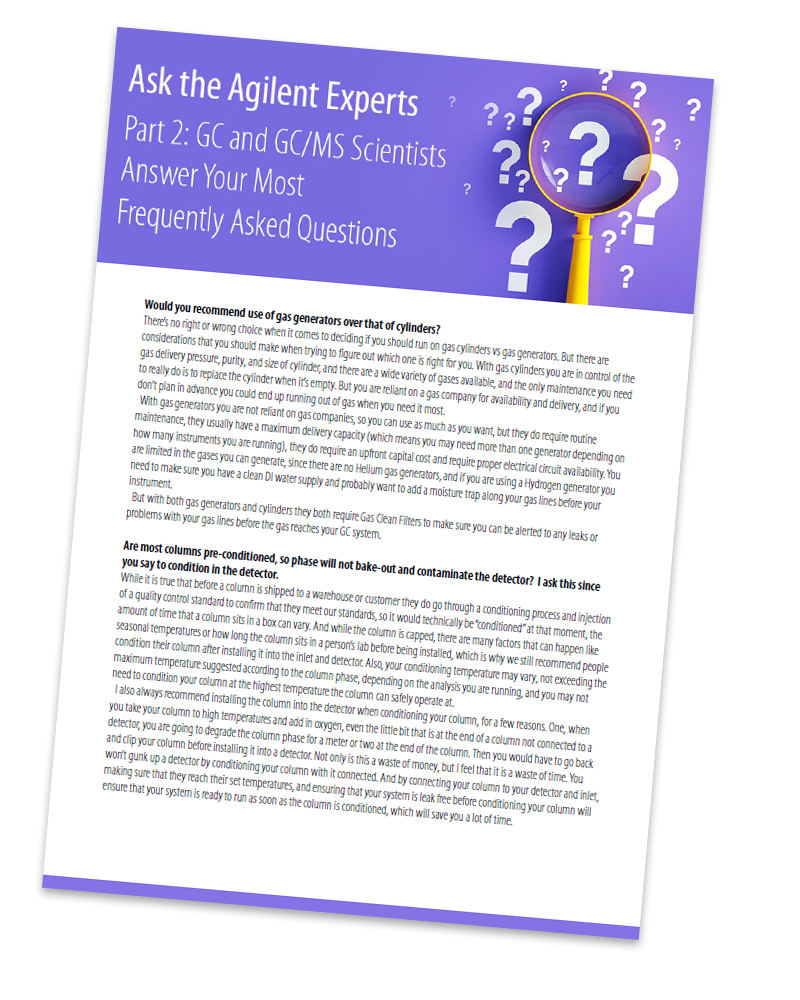In Part 2 of this webinar series, Agilent experts continue to discuss some of the most frequently asked questions about GC and GC/MS. View the on-demand presentation and find answers to some of the most frequently asked GC and GC/MS questions.


Format: On-demand
Duration: Approximately 65 minutes
Sometimes the simplest of questions can have the most complex answers. A question about source maintenance can further a discussion about having quality control criteria, front end GC maintenance and how to use tune reports to understand the health of a source. A question about transitioning to hydrogen can open a discussion on the need for gas filters (and an entertaining story about a hydrogen generator experience gone bad), identifying the best column dimensions for your analysis needs and if H2 with GC/MS makes sense for your analysis.
There’s no such thing as an easy answer, because the answer always depends on many different factors. Therefore, we have complied a list of some of our most frequently asked questions, which may seem like simple questions, but in reality they have anything but simple answers.
By viewing this presentation you will learn:
- best practices with GC and GC/MS systems – from liner and column selection to why gas filters matter and instrument prep recommendations, and
- why there is not always an easy answer to most GC(MS) questions
Plus download the top attendee questions answered
 Registering for the on-demand presentation will also give you access to Angie and Vanessa's answers to the top ten questions submitted during the live broadcasts, which have been compiled into a PDF.
Registering for the on-demand presentation will also give you access to Angie and Vanessa's answers to the top ten questions submitted during the live broadcasts, which have been compiled into a PDF.
You'll also gain access to a number of useful accompanying resources, such as brochures and web tools as detailed below:
- Agilent GC/MS Columns & Supplies
- The Right Connections Make All the Difference
- GC Column Selector Tool
- Vapor Volume Calculator

Presenters:  Angie Smith-Henry
Angie Smith-Henry
(Gas Chromatography Applications Chemist, Agilent)
Angie is is an applications chemist for GC and MS Supplies at Agilent in Wilmington, Delaware, USA. Previously, she was an applications chemist for the MSD Solutions and Applications group with a focus on developing analysers and applications for energy, chemical and environmental markets. Angie holds a PhD in Physical Chemistry from Lehigh University and BS in Chemistry from Juniata College.
 Vanessa Abercrombie
Vanessa Abercrombie
(Gas Chromatography Applications Chemist, Agilent)
Vanessa is a GC Applications Chemist at Agilent in Folsom, California, USA. Vanessa has a broad background in GC and GC/MS, including experience as an instrument chemist at Bode Technology in Virginia working under contract to the FBI’s Laboratory Division. Prior to that, Vanessa worked for ETS Labs in St. Helena, California as an Analytical Chemist where she researched and developed quantitative separations by GC/MS and UHPLC for beer, wine, and spirits. She holds a Master of Forensic Science from The George Washington University and a Bachelor of Arts in Chemistry from Sonoma State University.
Moderator: Diane Turner
Diane Turner
(Director & Senior Consultant, Anthias Consulting)
Diane Turner is Director and Senior Consultant of Anthias Consulting in Cambridgeshire, UK. A Warwick University graduate, Diane completed her masters in Analytical Chemistry and started her career in environmental chemistry, later gaining significant experience as an Applications Chemist. Diane’s area of research through her PhD studies at The Open University was disease diagnosis. She has developed methods for, and given support and training for companies in most industries around the world for more than 20 years. Diane also holds voluntary roles with The Royal Society of Chemistry and other scientific organisations.



